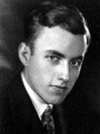 Citations
Citations
No need for female Viagra
Aging women become sexually dysfunctional
at only about half the rate of men, according to a 30-country
study led by U of C sociologist Edward Laumann. The results
of the survey, based on interviews last year with 27,500
men and women aged 40-80, were presented at the October
meeting of the International Society for the Study of Women's
Sexual Health. Men reported increasing instances of erectile
dysfunction—up to 50 percent among 80-year-old males. Among
women, 31 percent lacked interest in sex, 22 percent were
unable to orgasm, 21 percent found sex unpleasurable, 20
percent had trouble lubricating, and 14 percent experienced
pain with sex. "Only 'trouble lubricating' has highly
significant age effects," Laumann says. The survey,
funded by Viagra maker Pfizer Inc., also found that two-thirds
of men aged 70 or older have a potential sex partner, while
less than one-third of women do.
 |
| John Knox in 1934 |
A portrait of the
law clerk as a young man
John Knox, PhB'30, had one of the worst yet most honorable
jobs in Washington, D.C., clerking for the relentless Supreme
Court Justice James C. McReynolds in 1936-37, when President
Franklin D. Roosevelt tried to "pack" the court
with New Deal supporters. Five years after Knox's death,
Dennis Hutchinson, professor and associate dean in the College
and senior lecturer in the Law School, and Emory University
law professor David J. Garrow have edited Knox's memoirs,
which the U of C Press published this fall. The Forgotten
Memoir of John Knox describes McReynolds's bigotry,
Knox's clerkship as chiefly a stenographer and typist, and
the clerk's private switch, despite his boss's dissent,
to supporting the New Deal.
Religious motives
for terrorism
Even though President Bush carefully avoided tying the U.S.
war on terrorism to Islam, the September 11, 2001, attackers'
motives were profoundly and intensely religious, Divinity
School professor Bruce Lincoln, AM'73, PhD'76, argues. In
Holy Terrors, to be published by the U of C Press in
January, Lincoln dissects the religious references in the
instruction manual given to the hijackers. He also compares
the subtle religious rhetoric in Bush's October 7, 2001,
speech announcing military action in Afghanistan with a
videotape Osama bin Laden released hours later, showing
that both leaders use religion to unite their people. Ultimately,
Lincoln argues, religion is widely considered the most viable
and effective instrument of rebellion against economic and
social injustices.
Your cheating No.
2 pencil
Using a computerized method that tracks unusual patterns,
U of C economist Steven Levitt helped the Chicago Public
Schools system document instances of standardized-test cheating
in at least seven elementary schools last May. The statistical
model identified patterns in the students' answers that
suggested adults may have assisted them. Officials fired
six teachers and an aide and disciplined three principals
after the investigation.
Do try this at
O'Hare
Airport bystanders, including six with no prior training,
used defibrillators to save 11 of 18 cardiac-arrest victims.
In 1999 the devices were installed in glass cabinets at
Chicago's O'Hare, Midway, and Meigs airports-the first in
the world to try them. In the October 17 New England
Journal of Medicine, coauthor Lance Becker, professor
of clinical and emergency medicine, details the 61 percent
success rate as well as the fact that ten of the 11 patients
were alive a year later and none
suffered brain damage. Considering the number of untrained
people who successfully used the devices, Becker says, the
label warning that only trained rescuers should use them
"probably needs to be reevaluated."
— A.B.


![]() Contact
Contact
![]() About
the Magazine
About
the Magazine ![]() Alumni
Gateway
Alumni
Gateway ![]() Alumni
Directory
Alumni
Directory ![]() UChicago
UChicago![]() ©2002 The University
of Chicago® Magazine
©2002 The University
of Chicago® Magazine ![]() 5801 South Ellis Ave., Chicago, IL 60637
5801 South Ellis Ave., Chicago, IL 60637![]() fax: 773/702-0495
fax: 773/702-0495 ![]() uchicago-magazine@uchicago.edu
uchicago-magazine@uchicago.edu
